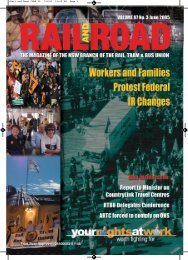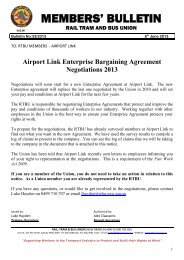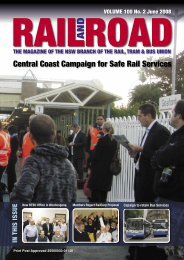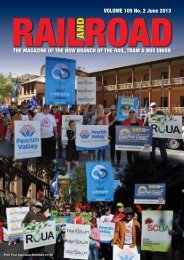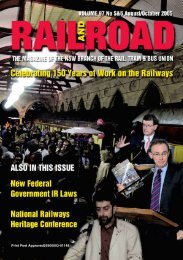Safety Matters - Rail, Tram and Bus Union of NSW
Safety Matters - Rail, Tram and Bus Union of NSW
Safety Matters - Rail, Tram and Bus Union of NSW
You also want an ePaper? Increase the reach of your titles
YUMPU automatically turns print PDFs into web optimized ePapers that Google loves.
<strong>Safety</strong> Equipment<br />
There are regulations specifying the correct safety equipment you must<br />
use when h<strong>and</strong>ling hazardous materials.<br />
Example:<br />
Eye <strong>and</strong> face protection (goggles <strong>and</strong> face shield)<br />
Breathing canisters<br />
Protective clothing (gloves, overalls, boots)<br />
Consult the Material <strong>Safety</strong> Data Sheets for this information.<br />
Exposure st<strong>and</strong>ards <strong>and</strong> air monitoring<br />
The Hazardous Substances Regulation requires employers (<strong>and</strong> the selfemployed)<br />
to control exposure to ensure that the exposure <strong>of</strong> an employee,<br />
or other persons at the workplace to hazardous substances is prevented, or if<br />
that is not practicable, minimised.<br />
Clause 51<strong>of</strong> the <strong>NSW</strong> OHS regulation states that the employer must ensure<br />
that no person at a place <strong>of</strong> work is exposed to an airborne concentration<br />
<strong>of</strong> an atmospheric contaminant that exceeds or breeches a st<strong>and</strong>ard<br />
referred to in the Worksafe Australia publication Exposure St<strong>and</strong>ards<br />
for Atmospheric Contaminants in the Occupational Environment. This<br />
is relevant where inhalation is the main route <strong>of</strong> entry. The exposure<br />
st<strong>and</strong>ard is also given in the MSDS, if a st<strong>and</strong>ard has been allocated.<br />
If spraying produces particles in the air, like vapours or aerosols, then when<br />
doing a risk assessment it may be appropriate to assume that the airborne<br />
exposure st<strong>and</strong>ard is likely to be exceeded <strong>and</strong> that control measures such as<br />
respirators or other PPE are necessary..<br />
If there is uncertainty about risks, it may be necessary to measure airborne<br />
concentrations <strong>and</strong> compare these with the m<strong>and</strong>atory exposure st<strong>and</strong>ards.<br />
This may be useful for fixed locations such as indoors or situations <strong>of</strong> <strong>of</strong>flabel<br />
use. Care must be taken when applying these to outdoor situations<br />
where conditions are variable, such as changes in the wind.<br />
Personal protective equipment (PPE) for exposure to chemicals<br />
PPE should only be relied upon where it is not possible to control exposure<br />
by one or more <strong>of</strong> the above measures. PPE should be used:<br />
<strong>Safety</strong> <strong>Matters</strong> A Guide for Workplace OHS Representatives<br />
SECTION FOUR<br />
RAIL<br />
TRAM AND BUS<br />
69<br />
OHS Factsheets<br />
U N<br />
I O N





